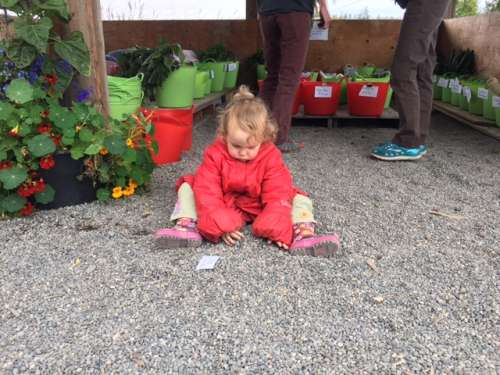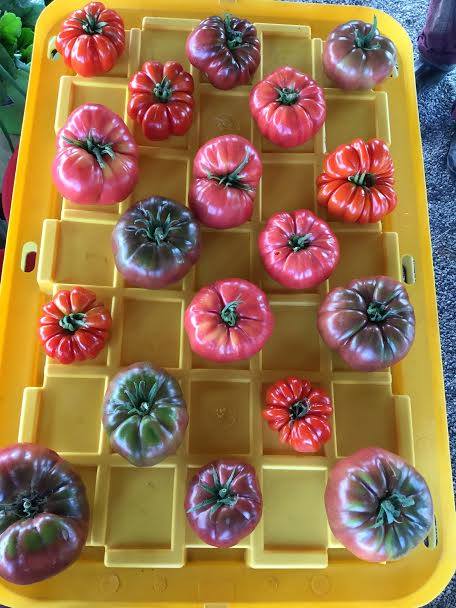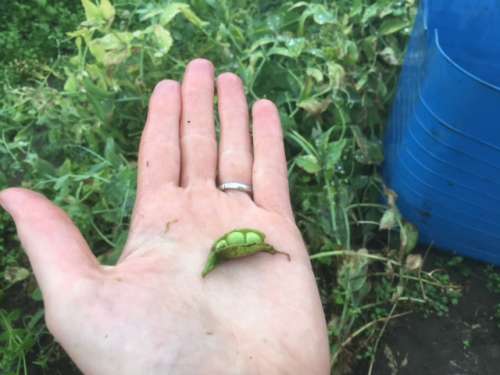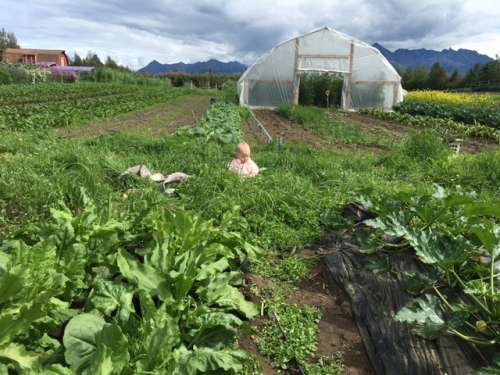Hi Farmgirls! Harvest season is in full swing up here in Alaska, I imagine your gardens are producing (or everything is bolting?) in excess with the amount of heat the lower 48 has been getting. On the farm, we have seen especially high yields of peas, zucchini and broccoli–nearly to the point of having too much to sell and eat! In the past, I would have dedicated a few days to putting up food for the winter, but it turns out that small children make this pretty difficult. Who would’ve thunk?

These girls are so helpful! Yes, that is a mud goatee on Opal…soil is good for gut flora, they tell me.
Did you know that Americans, on average, throw away 40% of their food? Food makes up the biggest portion of garbage that makes it into landfills. One statistic I saw said that 50% of all seafood that is purchased ends up in landfills! What?! This is infuriating when I think about how the world’s fisheries are very much in danger of collapsing due to over fishing. I’d like to think that the waste is mostly bones and heads and fish skin…but even those undesirables could be very useful as natural fertilizers, broths and animal feed. All of this contributes greatly to greenhouse gases and binds up a lot of nutrition that would otherwise hopefully be returned to soils through composting and animal waste.

Ava makes “purple cakes” out of pebbles any chance she gets. Nothing goes to waste in her world!
I, by no means, am innocent when it comes to food waste. In fact (this is a major confession!), I’m guilty of cleaning out my fridge, finding a container that has been in there for goddess knows how long, and throwing away the whole container because I was too afraid to open it…yeah, I know, privilege at its finest. In a little bit less wasteful and less gross ways, I am often too tired or lazy to keep scraps or old food to feed to friends’ chickens or add to others’ compost piles. The trash can is too convenient, sometimes. That will be the ultimate downfall of humanity, I think: convenience.

These heirloom tomatoes are too beautiful to end up in a landfill!
However, I’m trying to fix this problem in small, achievable ways! Over the summer, I’ve instituted a few “rules” that I’m hoping to make habits. One of the most effective I’ve found is meal planning. I don’t plan out every single meal every day, I just make a flexible dinner calendar for the week. Since last minute get togethers or unexpectedly late nights happen regularly, I plan for five dinners at home per week. The “meal” is also loose–pretty much just a protein, veg and carb. I take an inventory of what we have that needs to be eaten and put those at the beginning of the week and stick others in where they fit. I try to make enough for leftovers for lunch, and we have a few breakfasts that we cycle through. I bet a lot of you have been meal planning for years and have great tips! I’ve found that this frees up a lot of time and makes every day life a bit less stressful. Plus, if I’m working late then Evan can see what his options are and make dinner, too!

My in-depth meal plan for this week. Detailed enough to help me focus, flexible enough to allow for schedule changes. Plus some toddler input…

2.5 peas in a pod! Too ugly for selling, but will be yummy in my tummy come December…
The next major thing I’ve done is put up food for the winter in mini batches. I work on Saturday, Sunday, Wednesday and sometimes Monday or Friday, so my freezing/canning day is usually Thursday. I’m so fortunate and grateful to be able to bring home amazing, beyond organic, locally grown, lovingly grown produce from the farm; but sometimes I bring home too much to eat in a week. I also bring home “ugly” castaway veggies quite often that will otherwise be fed to farm animals (lucky, healthy animals!). I’ve gotten in a pretty good routine of preparing and freezing food that has been in the fridge for a week or so. It is still in perfect condition and will be a special treat during the short days and long nights of winter.

Zucchini, anyone?
My food processing days usually involve caramelizing one type of vegetable, roasting another and blanching another one or two. It tends to warm up the whole house! We’ve had a TON (maybe literally?) of zucchini, which I’m sure is very familiar to most of you. The head farmer told me that she caramelizes zucchini to freeze for winter casseroles and sauces. It is so, so yummy, even as a spread for crackers! I highly recommend it, look for the recipe at the end of this post! A recent Thursday food processing session involved: one jelly roll pan of roasted beets, one #10 cast iron skillet of caramelized zucchini, one bunch of chopped and blanched kale, six chopped and blanched baby boc choi and just under half a gallon of freshly picked blueberries. The roasting and caramelizing spanned a long amount of time, but the labor and attention involved was minimal; and the blanched veggies went from raw to in the freezer in about twenty minutes. I put it all in ziploc baggies or mason jars, label with date and contents, and stick them in the freezer! I will use them over the winter for soups and stews, casseroles, savory pies, and side dishes; and we will be able to enjoy the freshest produce now instead of working our way through older produce first.

Evidence of blueberry picking!
By doing this, we can eat the freshest, most responsible food we can throughout the year. It also saves quite a bit of money. While blueberries are arguably one of the healthiest fruits out there–it doesn’t seem environmentally or fiscally healthy to buy $6 pints of blueberries that have come from Chile in January. This is especially true when they were freely available to be foraged by anyone on public land a few months earlier. And buying zucchini at the grocery store when it was being left on people’s doorsteps over the summer? That is lunacy.

Ava ate more blueberries than she picked, and I can’t blame her!

Opal in an alpine blueberry patch.
As I write this, I see that I am extremely lucky to be blessed with an abundance of food and the knowledge, ability and time to be so conscious about it. I hope that you, too, are blessed with an abundance of something from your garden, a neighbor’s garden, your community’s farmer’s market, or even good deals on in-season foods from the grocery store. Are the strawberries super cheap? buy and freeze them now before their price quadruples in a couple months. Maybe you struggle with putting food up because of the up front time investment–but I’ve found that putting up small batches is worthwhile and not very intimidating! When making dinner you can blanch excess veggies and plop them in the freezer. You can can just enough jars of tomatoes or beans to fill up the pressure canner once or twice!

This photo is all for fun. I hope this half albino broccoli matures properly. So beautiful!
Now, when it comes to pickles and jams the micro batches might not work, but for the minimally processed food this system is working for me!
Here is a very basic guide to what can be put up and how:
Foods to Chop, Blanch and Freeze: greens like spinach, kale, chard, collards, choi; peas; beans; broccoli; cauliflower; brussels sprouts; zucchini; cabbage; carrots;
Foods to Caramelize and Freeze in Small Batches: onions; zucchini; tomatoes;
Foods to Chop and Freeze (without cooking): berries; onions/leeks; peppers; meat and fish; other fruits
Foods to Roast and Freeze: Beets; potatoes; winter squash; sweet potato;
Foods to pressure can: most veggies; beans; meat and fish;
Foods to can in hot water bath: Jams/jellies; tomatoes; pie filling; pickled foods;
This is a very basic list for those of you that are just beginning and there are many more foods that can be preserved in these ways and others. There are also the amazing worlds of dehydrating and fermenting (which I know pretty much nothing about), and cold storage (for those lucky enough to have a cellar!). There are so many ways to keep foods for the unproductive months if you have the time and means.
What are you filling your freezer and pantries with during this harvest season? Do you have any tricks of the trade to share with us?!
Until next time,
Sending peace and love from Alaska,
Alex, the Rural Farmgirl
p.s. Here’s my caramelized Zucchini recipe 🙂
Caramelized Zucchini
Ingredients:
- 10-15 small zucchini (enough to fill your pan to the brim and preferably those that have minimal seed formation)
- 2 cloves garlic (more or less to taste)
- 2 T olive oil
- 2 T butter
- one bunch of fresh leafy herbs (eg. Parsley, Basil, Sage, Tarragon)
- optional spices to taste
- salt and pepper to taste
Directions:
- slice zucchini into 1/4 inch discs
- dice or mince garlic
- heat heavy bottomed skillet over medium heat
- add olive oil and butter to pan
- once butter has melted add zucchini, garlic and some salt to pan, stir to coat
- lower heat to just above lowest setting
- cover and stir once in a while to prevent browning
- once zucchini has all cooked through and breaking down remove lid to reduce (it takes almost two hours on my stove to get to this point)
- chop leafy herbs
- Add herbs, salt, pepper and other spices
- continue cooking and adding flavor until you like it! Taste frequently, this takes another 45 minutes to an hour on my stove.
- Let cool for about 30 minutes
- scoop ~one cup into quart sized freezer bags or suitable mason jars
- Use within the week or freeze for later use
- To use from frozen just place container in fridge the day before you want to use it.
- Great in pasta, casseroles, soup, etc.

This is just a cute picture of a farm baby.











I just made zucchini chocolate bread with some of my zucchinis. wow, it tastes like brownies. Can’t tell zucchini is even in there. I cut into small chunks and froze it for a sweet snack. I will try your Caramelized Zucchini. I make lots of soups in the winter in the crock pot. That will blend in well. I just caught up on all your posts. I missed you, don’t know how I missed them. Keep up your good work. Joy
Thanks for the check in, Joy. I, too, LOVE zucchini chocolate bread. Zucchini chocolate chip bread was a staple during my childhood summers. I will have to try your frozen brownie chunk treat. It sounds delicious!
Just talking about this very topic with friends, ’tis the season to put good food by! Thanks for the post brimming with good information, lovely photos and a recipe to boot! Have a great day Alex, sounds like anyone that drops by your home is treated with delicious nourishing food.
Thanks, Diana! You’re right–I love to feed others good nutritious food when possible and feel a bit guilty when I don’t. I hope this finds you well!
Hi there Alex! Love the pictures of the girls, the veggies, and the dirt! What a beautiful combo- I know that all too well! Right now in my area peaches are in but very sparse due to a late spring freeze that killed about 60% of the crop so we get what we can get. My girls and I could only pick one bushel and we canned them in apple juice instead of a sugar syrup. We will savor our few jars this winter! We will be putting up more applesauce instead to help keep enough jars of fruit on hand. Still waiting to see how the pears are doing(those are canned in white grape juice). We are also in the middle of putting up green beans and sweet corn and the tomatoes are FINALLY starting to ripen! Soup, sauce and salsa to can!! We don’t have the amount of zucchini that you do but I am always looking for new ways to eat it and yours sounds really good! We also put up jams and pickles (we NEED pickles!) and flavored vinegar. My girls are older now and are able to help out more (although there can be a good amount of whining involved some days!) but they have always loved to listen for the pop of the lids when they seal! I wish you and your family many happy lid pops too!!
Awesome, Amanda! Thanks for sharing your pantry staples with us. I’ve been wondering about how to can fruit without sugar, thanks for the fruit juice tip. We also need pickles!! I’m thinking of adding daikon radish to the jars to extend our cucumber supply. Hope you are well!
I have been guilty of food waste in the past. Sometimes I struggle because I am so busy with life or simply forgot I put it in the fridge. The last 2 years I have made sure to put aside what I know I will eat and then I freeze the rest. I have been doing this mainly with zucchini, because that is what I have overwhelming amounts off. Right now we are staring to get pears so I am getting ready to can them to prevent waste. The one thing that has recently come to mind is composting. Since I have started my own garden this year I have started noticing so much that goes uneaten, such as the tops to carrots. I have been running the idea past my husband to see what we can do with all these extras rather than throw them in the garbage. Thanks for the recipe and other ways to save my food for later use! It’s nice to expand my food saving skills.
I am SO guilty of food waste every day. We all live lives that are arguably too busy, but we do the best we can, right? I love compost piles/bins. I highly suggest it! As soon as possible (when we live somewhere where possible..) I am starting a compost system. Let us know if you get it going. Maybe I should have a post dedicated to various farmgirl’s compost systems…hmm. Where do you live? Some cities even have municipal compost programs! Thanks for being honest with us and sharing your successes. Zucchini forever!
I grew buckingham (yellow zuch) and cocozelle (striped zuch) this year. Two plants produce prolifically and I think I could give every family on my block enough to eat every single week. I’ve had to be creative with preserving! We are swimming in zuch! I’ve made zucchini “pickle” relish which turned out awesome (I canned it), shredded it up and put it in zip locks to freeze for use later to make squash croquettes, and of course we eat it ever stinkin’ day! 🙂 I had not ever considered blanching and freezing kale. I do eat kale every day in the summer, when production is high. I saute bacon and onion, add in the kale and water, simmer until done. REALLY great for breakfast – wakes you right up! I miss it in the winter when I don’t have it, so blanching and freezing will certainly help! Thanks for the tip!
Your breakfast kale sounds amazing! The blanched Kale isn’t as good as the fresh summer stuff, but it definitely works and is still tasty. Zucchini pickles, yum! Thanks for sharing your tips.
Great post!!! for some reason my garden doesn’t grow those sweet, beautiful babies, tee hee. Really love all your info and your super pics. God bless.
Real life cabbage patch kids! Thank you 🙂